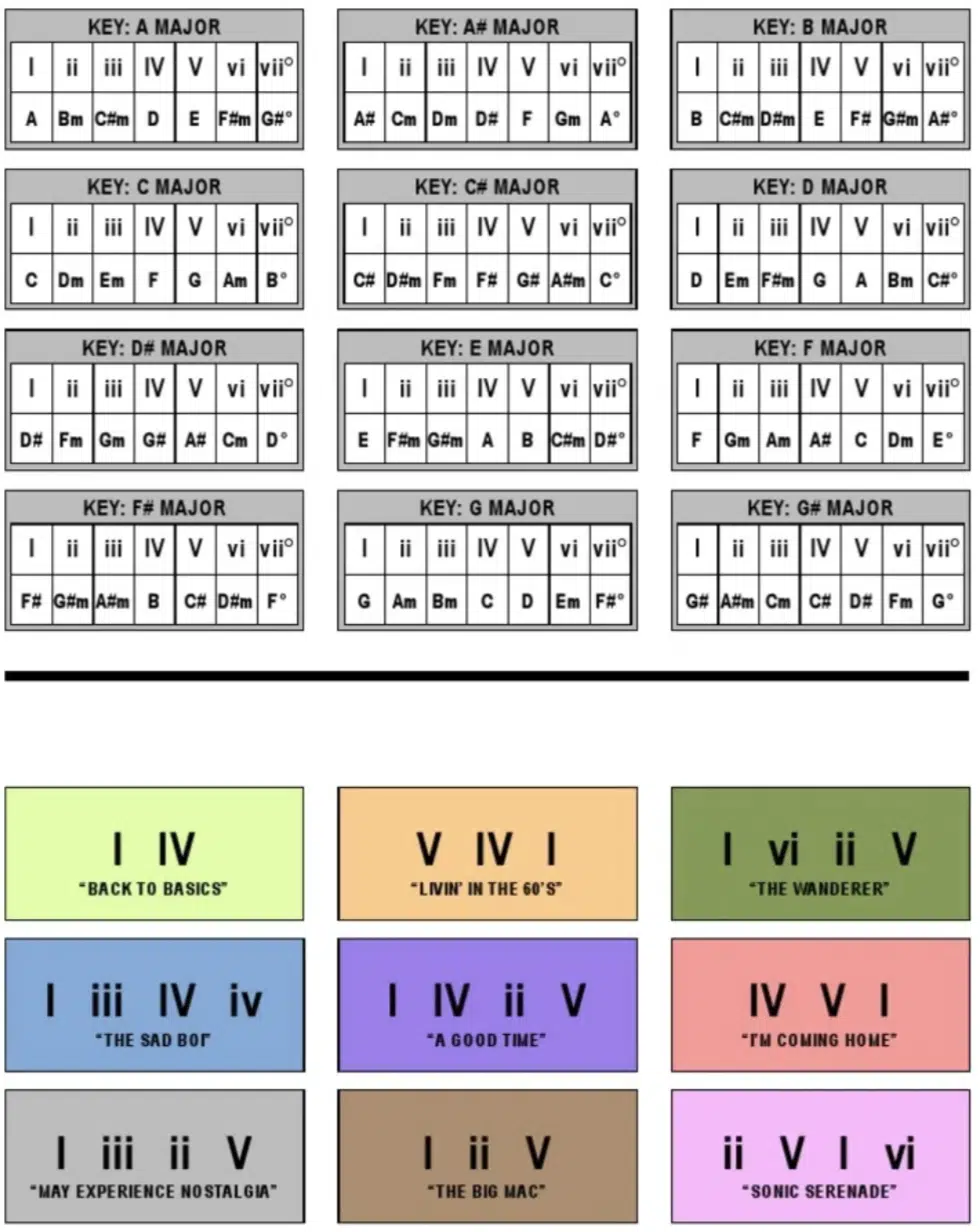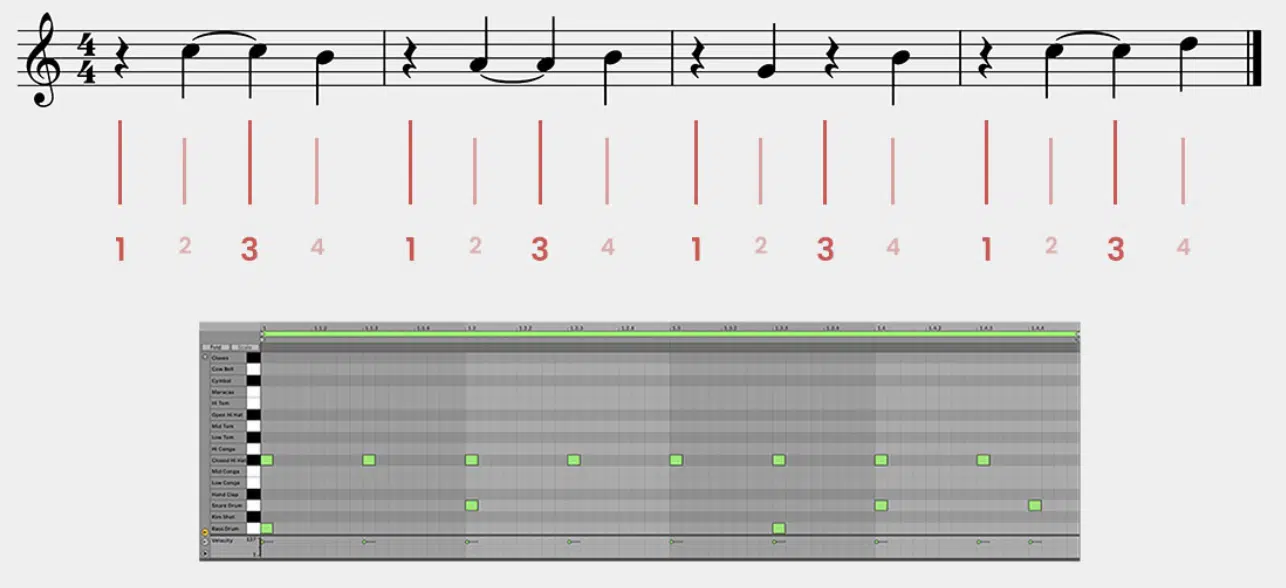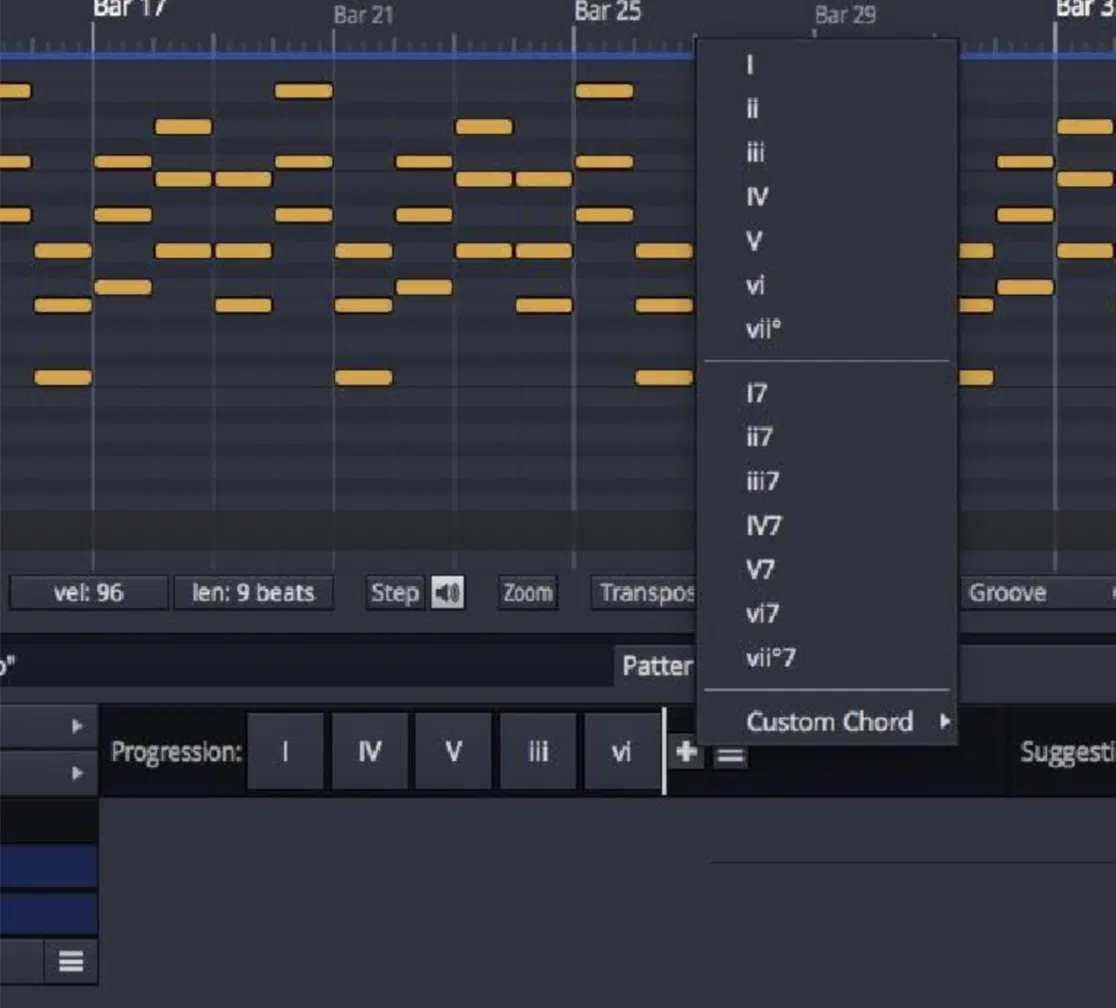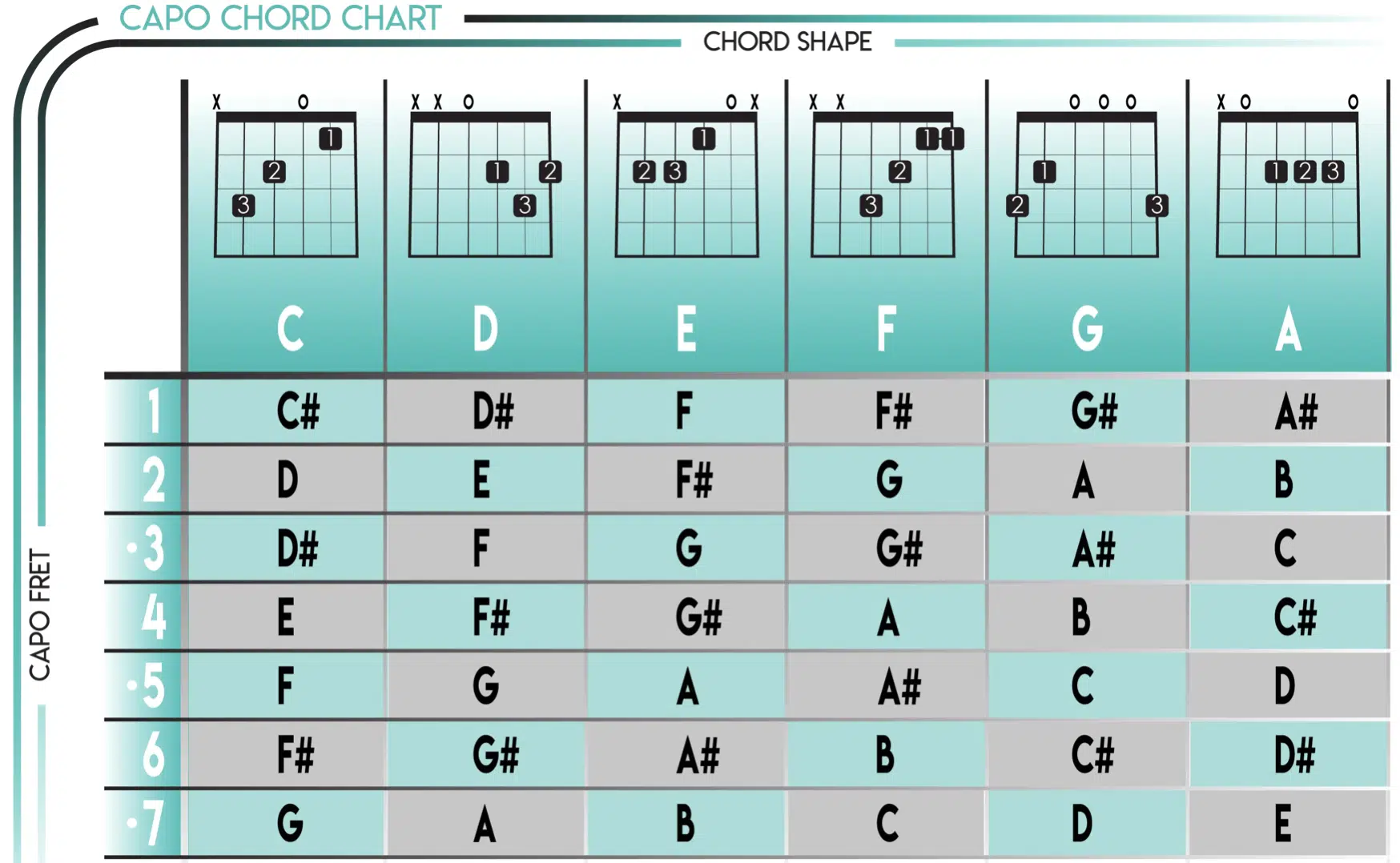Indie chord progressions are all about breaking rules, deep emotions, and adding unique twists that instantly capture listeners’ attention.
They create an expressive atmosphere, shift easily between sad and upbeat, and can completely transform a track’s feel.
Plus, they’re versatile, dynamic, and never predictable.
As guitar players or producers who are getting into the indie game, it’s super beneficial to know all about them.
That’s why we’re breaking down everything about indie chord progressions, like:
- Structure and core elements ✓
- Balancing major and minor chords ✓
- How rhythm impacts progressions ✓
- Using unusual chord changes ✓
- 5 signature indie progressions ✓
- Examples of chord shapes to use ✓
- Rhythmic variations in strumming ✓
- Combining progressions for variety ✓
- Creating your own unique indie chord progressions ✓
After reading this article, you’ll know the 5 signature indie chord progressions, so you can use them like a boss to create that signature indie sound.
Plus, you’ll get expert tips and tricks for creating your own unique progressions.
This way, you can add emotional depth, develop your own style, and keep listeners hooked, just like a professional.
Side note: we usually tweak our articles for music producers, sound designers, etc., but we’re also including information for live guitar players today as well.
Table of Contents
The Essence/Structure of Indie Chord Progressions

Indie chord progressions typically mix traditional major chords with unexpected minor chords to create a unique balance of familiarity and deep emotion.
For example, starting with a major I chord (e.g., C) and transitioning to a minor vi chord (e.g., Am) adds an immediate nostalgic feel, which sets the tone for the genre.
A classic indie twist involves adding a minor ii chord (e.g., Dm) right after the major IV chord (e.g., F) 一 giving the progression a more surprising edge.
This is the essence of many indie rock chord progressions as you’ll soon learn.
I always use open chord shapes, like open E minor or open G, which allow each note to sustain, for a more ‘airy’ sound (perfect for slower strumming patterns).
Side note, open chord shapes are chords that use open strings (strings that aren’t fretted).
As a digital producer, using guitar plugins that emulate guitar-like textures can help you bring that same warmth to the table.
Like adding reverb and delay to make the notes stand out more clearly.
These types of progressions benefit from layering MIDI tracks, which can add depth and variation, making the indie rock feel more dynamic and raw.
The key is to mix unexpected chord shapes with simple rhythms for a natural yet unpredictable flow that defines the indie rock genre.
Don’t worry, we’ll break it all down and you’ll learn all about creating your very own indie chord progressions from scratch.
Rhythm & Tempo in Indie Rock Chord Progressions

The rhythm and tempo of your indie chord progressions can seriously shift the feel of a track, just like any other genre.
Slowing down a common progression like I-IV-V (e.g., C-F-G) with relaxed strumming creates a more intimate, almost depressed vibe.
This is a signature sound you’ll hear in many indie songs.
For example, set the BPM (beats per minute) to around 70-85 to create a slower, laid-back feel and use longer note durations, like quarter or half notes.
This way, you’ll let each chord ring out for more space/emotion.
You can also use softer attack settings on virtual instruments or reduce the velocity of MIDI notes to create a gentler touch.
Adjusting the reverb decay time to around 2-3 seconds adds an atmospheric, open vibe that enhances the overall emotional impact.
Speeding up the same progression with fast-paced strumming gives it a lively, energetic feel, which makes it fit better with upbeat indie rock anthems.
Try increasing the BPM to around 120-140 to create this sense of urgency, and use shorter note durations, like eighth notes.
You can also emphasize downstrokes for a driving rhythm.
If you’re using MIDI, set the velocity of each note higher (around 90-110) to give more punch to the chords.
You can also add a touch of delay, with shorter feedback settings, to make the sound bounce more and increase energy for extra hype.
-
Pro Tips

Syncopation or (emphasizing off-beat notes) is a great way to add rhythmic unpredictability to your indie chord progressions.
For example, try emphasizing the ‘and’ beats (e.g., 1-and-2-and-3-and-4) by increasing the velocity of these notes.
This makes them sound more complex without changing the actual chords.
You can also use groove templates in your DAW to add swing or shift the timing of individual notes slightly off-grid 一 giving them a more human, natural feel.
You’ll also want to play around with tempo automation in your DAW.
Increasing or decreasing the speed within a progression can add dynamic movement to your indie chord progressions that really blow people away.
Start by gradually increasing the tempo by 5-10 BPM during a transition from verse to chorus to build intensity.
I also suggest decreasing the tempo by 5-8 BPM during breakdowns to create a more dramatic and introspective mood.
By playing around with rhythmic changes, you add variety and texture to your music, keeping listeners engaged with both the chords and overall flow of the track.
5 Signature Indie Chord Progressions That Are Absolutely Awesome
Now that we’ve covered the basics, let’s dive into some of the most popular indie chord progressions that literally define the genre. These indie/indie rock progressions aren’t just common in indie music… They offer a blueprint you can use to build your own unique sound while playing around with different chords and shapes.
#1. I-vi-IV-V (e.g., C-Am-F-G)
If you’re wondering what the most instantly recognizable of all the indie chord progressions is, the I-vi-IV-V progression is it.
This indie progression is broken down by:
- Starting with the major I chord (C)
- Moving to the minor vi (Am)
- Then the major IV (F)
- Ending on the major V (G)
It’s the perfect blend of familiarity and warmth (that people really love).
You’ll find this structure super easy to work with because each chord shape is straightforward and to the point 一 making it ideal for beginners.
Try using open chords like open C and open F for a more resonant, full sound, especially with a slower strumming pattern to emphasize each note.
It works well with simple dynamics: dial in a gentle build-up in the verses and a powerful chorus, which you might have heard in songs by bands like Vampire Weekend.
#2. vi-IV-I-V (e.g., Am-F-C-G)
The vi-IV-I-V progression flips the classic progression we just talked about for a completely different feel/vibe:
- Start with a minor vi (Am)
- Follow it up with a major IV (F)
- Then, major I (C)
- Finally, major V (G)
This gives it a more melancholic yet uplifting tone (yes, both at the same time), which is a perfect fit for indie tracks aiming for an unmatched emotional punch.
It’s actually my favorite when it comes to indie chord progressions, just sayin’.
The minor start makes it feel more intimate, which you’ll hear in many indie rock ballads that really reel people in and get them emotionally invested long after the song ends.
You can use barre chord shapes for a tighter sound, or keep it open for a more airy feel when you’re trying to replicate this one.
Personally, I kind of slow the strumming here, letting each note linger before transitioning, creating a blend of vulnerability and hope.
NOTE: If you’re not sure what a barre chord shape is, it means pressing down multiple strings across the same fret with one finger (usually your index finger) to create a “bar.”
This technique allows you to play a chord with the same shape up and down the neck, making it easier to shift between chords and create a more consistent, compact sound.
#3. I-IV-V-IV (e.g., C-F-G-F)
This indie chord progression, I-IV-V-IV, is a simple major scale progression that’s very easy to play but is also surprisingly versatile.
Starting with the major I (C), moving to the major IV (F), then the major V (G), and returning to the major IV (F), it creates a circular, catchy feel.
For more dynamics, try playing it with a mix of open chord shapes like open C and F, paired with varying strum intensities 一 adding extra depth to your rhythm.
It’s a great progression to use when you’re looking for an upbeat, ‘anthemic’ feel, especially in chorus sections where repetition creates a strong hook.
To add an indie edge, try alternating the strumming pattern and incorporating syncopated rhythms to make it sound less predictable.
Remember, indie chord progressions are all about that sense of intrigue and surprise.
#4. IV-V-vi-I (e.g., F-G-Am-C)
This indie rock chord progression gives a hopeful, yet almost bittersweet sound, so if you’re looking for the ultimate emotional tension, look no further.
Breaking this indie chord progression, it:
- Starts with a major IV chord (F)
- Moves to a major V chord (G)
- Then a minor vi (Am)
- Ends on the major I (C)
Personally I like to use barre shapes for the F and G chords here as well because it adds a more driving feel, especially if you want a more intense build-up in a chorus.
You can play around with strumming variations, emphasizing off-beat notes for added groove.
NOTE: Try adding muted strums between chords to create a percussive effect 一 giving the chord progression more rhythm and drive.
This chord progression is a staple in many indie rock songs (and metal songs), known for its versatility across different genres, from slow ballads to upbeat anthems.
#5. I-V-vi-iii-IV (e.g., C-G-Am-Em-F)
The I-V-vi-iii-IV indie chord progression is one of the most dynamic indie chord progressions out there, hands down.
It starts with the major I (C), moving to major V (G), followed by the minor vi (Am), minor iii (Em), and back to the major IV (F).
This creates a mix of uplifting and contemplative vibes (which is, as we spoke about, what indie chord progressions are all about).
To get the most out of this indie chord progression, I like to emphasize the minor chords by letting the notes ring out longer 一 creating a more introspective feel.
Go ahead and give it a listen (above) so you can really hear what I’m talking about.
PRO TIP: You can use open chord shapes for a raw, resonant sound, or power chords for a tighter, punchy vibe.
And also Keep in mind that tweaking the rhythm by slowing down the strumming in the verses and speeding it up during the chorus brings out its full emotional range.
Side note, if you’re unaware of what power chords are, you can find out all about that in our power chords article.
How to Create Your Very Own Indie Chord Progressions

To create your very own indie chord progressions, you’re going to start by choosing your base chords, which form the foundation of any progression.
Begin by picking a key (the set of notes that defines the tonality of your track), for example the key of C major includes chords like C, Dm, Em, F, G, Am, and B diminished.
For a more indie feel, try starting with a minor vi chord (e.g., Am) instead of a major I, which instantly gives a more gloomy vibe.
Next, play around with unusual chord changes by moving unexpectedly, such as jumping from a major IV (e.g., F) to a minor ii (e.g., Dm), which adds that distinct indie twist.
For example, try moving directly from a major IV (e.g., F) to a minor ii (e.g., Dm) to add a sudden shift that can create unexpected tension/unpredictability.
Another example is jumping from a minor vi (e.g., Am) to a major V (e.g., G) 一 creating a sense of contrast that adds depth to your progression.
Incorporating rhythmic variations is also key as we spoke about earlier.
So again, you’ll want to adjust the strumming pattern by adding syncopation, meaning you’ll emphasize off-beat notes to make the chord progression feel more dynamic.
As digital producers, try layering your guitar chords with MIDI effects, like reverb, delay, and chorus, to create atmospheric textures that highlight each note.
You can also use your DAW’s chord generator tools to explore different shapes and chord progressions quickly.
NOTE: Experiment with features like “randomize chord voicings” to find unexpected combinations that fit the indie rock genre perfectly.
The best indie tracks often come from playing around with unconventional transitions and rhythms, so keep experimenting… and that’s what the indie rock genre is all about.
It’s all about breaking the rules and finding unique ways to blend emotion and structure, so don’t be afraid to try something new!
Bonus: Use Capo Placement & Combine Progressions (For Guitar Players)

Using a capo (a tool that clamps onto the neck of your guitar to raise the pitch of the strings) can transform your indie chord progressions into completely new sounds.
All without changing your chord shapes, which is awesome (it’s super popular in other popular genres too like rock, metal, etc.).
For example, placing the capo on the 3rd fret while playing open major chords like G, C, and D can bring a brighter, more uplifting feel to your indie rock chord progressions.
This will make them stand out in the mix, which is what you want.
You can try this in both:
- Slower ballads, where the higher pitch gives a more ethereal, dreamlike quality.
- Faster tracks to enhance the energy and clarity of each note.
If you’re looking for a more melancholic, darker sound, place the capo on the 7th fret and play open chord shapes like Em, G, and D.
This placement creates a more haunting feel, adding depth and character to your indie chord progressions.
Adjusting the capo placement changes the overtones of the chords, which makes them sound fuller or sharper, depending on the position.
Playing around with these methods/different guitar chords will help you add variety and maintain interest throughout the track.
Another technique is to combine two different types of progressions within one song, like merging a I-IV-V-IV with a vi-IV-I-V to create dynamic contrast between verse/chorus.
You can even try combining capo placements…
Use it on the 2nd fret in the verses and shift to the 5th fret for the chorus 一 creating a noticeable tonal change that can serve as a unique hook.
Remember, don’t be afraid to dial in different capo placements and chord combinations; it’s a great way to make your music 100% your own.
Final Thoughts
Indie chord progressions, as you now know, are all about creating unique, emotional soundscapes that balance unpredictability and familiarity.
They really bring depth, versatility, and mood to the table 一 making each track feel distinct and personal so it really sticks with you.
Plus, they let you explore various chord combinations, rhythms, and strumming patterns, all while maintaining a signature indie vibe.
Now, using the tips and tricks we talked about today (whether you’re a guitar player or digital producer), you’ll be knocking out these indie chord progressions left and right.
And, if you’re looking to enhance your tracks even further, you’ve got to check out the mind-blowing Free Guitar Loops pack.
It comes packed with seven free guitar loops, both processed and dry, along with 28 matching MIDI stems for ultimate flexibility.
It’s perfect for building on your indie chord progressions, whether you’re creating acoustic warmth or electric energy.
The loops are professionally created and 100% royalty-free, so it’s super easy to add high-quality guitar textures to your songs without any restrictions.
Whether you want to layer these loops or use them as the foundation for new progressions, they’ll add an authentic touch to your music.
Remember, mastering indie chord progressions is all about creativity, experimentation, and practice (and keeping in mind that it’s all about blending emotion).
Don’t be afraid to try unconventional transitions and rhythm changes as you create your indie tracks.
So keep experimenting, keep playing, and let your creativity flow.
Until next time…







Leave a Reply
You must belogged in to post a comment.